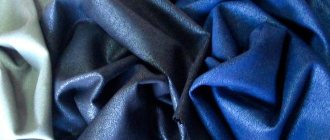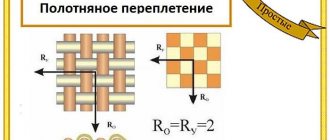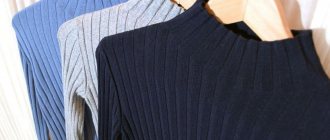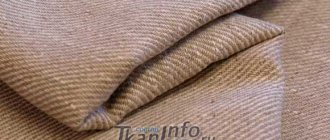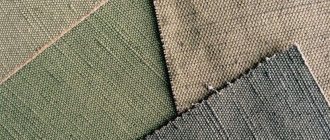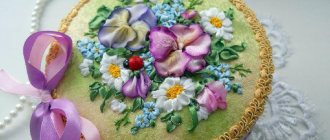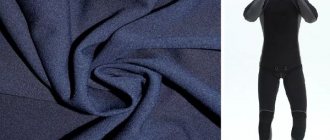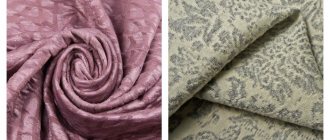Milano is a highly durable fabric. This is a type of knitwear with a tight weave. Milano fabric does not fray, is not see-through and drapes beautifully. There are several types of material. Products of complex styles are sewn from Milano. It is important to distinguish knitted fabric from Milana furniture textiles. There is nothing in common between them.
“Milano” and “Milana” – it is important not to confuse them
The name "Milano" is known in narrow circles. Most people don't know what it is. The composition of the fabric also remains a mystery. In this case, it is easy to confuse two completely different materials “Milano” and Milana.”
- Milano knitwear is a knitted textile material consisting of loops.
- Milana furniture fabric is a material reminiscent of velor with a pattern. It is created using Born-out technology. The pile is burned out with a laser, so it does not break. Some) call their products the same way as knitwear - “Milano”.
Types of Milano material
There are five varieties:
Jersey is an elastic material made from mixed fibers. It can be light silk, but more often thick wool, from which outerwear is made. The fabric was first produced on the island of Jersey in England. May be 100% wool. One of the common fabrics that Coco Chanel used to create her collections. The traditional version of jersey is a mixture of silk and wool.
Academician is a thick knitted fabric. Most of the composition is viscose. Sometimes half and half with polyester. Does not wrinkle, abrasion-resistant, strong fabric. Subject to a large number of washes. Looks new for a long time.
Punto is a strong knitwear with a dense weave of natural and chemical fibers. The composition usually contains a higher percentage of polyester. Elastic warm material with a matte surface. It stretches in both directions, but the length is minimal.
Roma is a fine linen with cotton in the composition. Mixed with viscose or other synthetics. It is easier to stretch along the weft than along the main length, but the difference is hardly noticeable.
Premium is a strong fabric with a small pile. Does not form pellets. Used to create suits or sheath dresses. Doesn't lose its shape, but shrinks. Before sewing clothes, wet-heat treatment is necessary.
These are the main common types of matter. New varieties of this fabric appear periodically. Sometimes Milano is mistakenly referred to as a type of high-quality expensive velor for furniture upholstery. The confusion arises because of the similar name - milan (or milan).
Description of fabric
To figure out what kind of material “Milano” is, just read the description and reviews:
- Dense knitwear made using the technology of machine horizontal or vertical knitting of fibers.
- The material is highly elastic, durable, and retains its shape well. Stretches well.
- "Milano" is painted in all sorts of colors. The fabric is distinguished by a rich palette of colors, prints, and designs. It holds color perfectly.
Customers write only good things in reviews of the fabric. Many people note the softness, warmth, and practicality of Milano. Clothes made from it do not lose their appearance even after a hundred washes. Things get slightly dirty and practically do not absorb odors. Dresses and pants can be worn for several days in a row and they will still remain clean.
Description
Milano is a mixed or two-component non-woven fabric. The outer surface of the knitwear is absolutely smooth and matte. The material is soft, smooth and elastic to the touch. Milano belongs to premium quality materials.
A distinctive property of textiles is high density
It is worth paying attention to Milano fabric, that it is an elastic fabric made of thick threads with a dense weave, which holds its shape in the product for a long time, does not wrinkle or crumble when cutting and sewing
Milano knitwear is endowed with stretchability, which is comfortable to wear and does not restrict movement. It gracefully follows the contours of the figure and hides imperfections.
The composition of knitted Milano includes cotton, wool, silk, viscose, elastane, polyester, polyamide, lycra and spandex. The combination of fibers can be very diverse. The fabric is made in one color and with a printed pattern. Less common are options with a pattern, jacquard or glitter on the front side.
It is worth noting that two types of material are produced with a similar name. One of them is “Milana” or “Milan”, which refers to furniture. It is a high quality velor fabric. It is made in a wide range of colors with an abundance of original colors. It looks expensive and luxurious, and is not susceptible to exposure to sunlight and external, unfavorable factors. And the second is the Milano that is discussed in this article, for sewing all kinds of clothes.
Compound
"Milano" is made mainly from synthetic fibers. Sometimes up to 20% of natural raw materials are added. The fabric may include:
- polyester;
- spandex;
- elastane;
- nylon;
- lycra;
- cotton;
- viscose;
- silk;
- wool.
The most inexpensive varieties consist of 95% polyester and 5% elastane or lycra.
What is Milano made from?
Milano fabric is a soft and at the same time elastic material with elastic properties, perfect for sewing clothes of different styles. The material consists of mixed fibers. Usually it is synthetic, sometimes cotton, wool and even silk are added. Viscose, polyester, wool and cotton are common fibers for making Milano fabric. What else is used:
- elastane;
- spandex;
- lycra;
- nylon;
- modal;
- polyamide;
- silk fiber.
Often several synthetic materials are combined. However, there are enough fabrics with natural and chemical fibers mixed.
This is interesting: Fabric for school uniforms: which is better, composition, comparative characteristics
Varieties
By combining different types of fibers and thread thicknesses, Milano fabrics with different properties are created. There are 5 main subtypes of this knitwear. We suggest exploring the features of each:
- "Academician". Knitwear made from mixed raw materials - synthetics and viscose. It is characterized by high density (up to 380 g/m²) and thickness. Recommended for sewing light outerwear - cardigans, jumpers, etc.
- "Punto." Very elastic, smooth material with a matte surface. The length stretches significantly less than the width. Widely used for tailoring mass market clothing. The composition is dominated by polyester. Some manufacturers add cotton.
- "Roma". The thinnest and lightest fabric. The composition often contains cotton, viscose or silk. Despite the small thickness, the fabric is not see-through and holds the fold. Stretches well (better across the width of the roll).
- "Premium". Dress and costume material with a moderately fleecy surface. It does not form pills, is very durable and warm. The composition contains viscose and sometimes wool. Used for sewing formal dresses and suits. It holds its given shape perfectly, but may shrink.
- "Jersey". Stretch fabric with mixed composition. Most often warm and dense, with the addition of natural wool. But a light version of “Jersey Milano” is also found (with silk).
Description
It is interesting to know what melange fabric is.
The material is a pleasant and soft canvas with a rough structure. A special feature is the use of threads of two or more colors, the same or different in thickness and composition, which gives diversity and uniqueness. Melange fabric is endowed with the ability to change color and texture upon close examination and at a distance. It's hard to imagine the melange color what it is. The term refers to a method for producing yarn or woven fabric consisting of multi-colored fibers. It is worth noting that there is no such shade in the palette, it is a combination. The yarn can be single-stranded or twisted from several threads that differ in tone. Mostly contrasting shades or with a difference of several halftones are used. A mix of multicolor threads forms a pattern similar to marble chips, a grainy pattern or fragments of an arbitrary configuration with a smooth color transition as in the photo.
The term "melange" is also used to refer to a pattern interspersed on other types of fabrics, such as gabardine, footer, suit or cooler.
Originally, melange was made from untreated cotton in several shades. Therefore, they began to call it a harsh canvas or motley. The material turned out to be durable and cheap, but lacking in attractiveness. Gradually, fibers were learned to be selected, processed and mercerized.
Melange is obtained from the following raw materials:
- wool fibers such as angora;
- dyed cotton yarn;
- additives of synthetic fibers of nylon, lavsan or nylon;
- purified spinning reverse for dark, woolly mélange yarns with high density.
Fabrics containing easily dyed synthetic threads look brighter and more embossed than monochrome, natural fabrics.
Characteristics
Milano knitted fabric has a number of advantages. Characteristics:
- Soft and comfortable. It is very pleasant to the touch and does not prick at all.
- Breathable. The matter allows air to pass through. Even the thickest knitwear does not float and allows the body to breathe.
- Durable. The fabric does not tear and has high elasticity.
- Elastic. "Milano" stretches beautifully. With its help, it is easy to emphasize the advantages of the figure - the roundness of the hips, a thin waist.
- Hygroscopic. Matter has the ability to absorb moisture. You don't have to worry about wet spots in your armpits.
- Doesn't fray, drapes perfectly. Beginning seamstresses can work with Milano. It is easy to cut. High density and elasticity allow you to realize the most daring design ideas and sew clothes to suit any figure.
- Durable. The fabric does not fade in the sun, does not fade, is not afraid of water, fungus, and does not pill. Things from it look new for several years.
- Easy to care for. The material does not wrinkle, is slightly dirty, does not attract dust and does not collect animal hair.
Milano clothes are cozy. It does not restrict movement and allows the body to breathe. It can be worn every day, worn to events, to the office, to a cafe, or for walks. Dress made from Milano fabric:
Advantages and disadvantages
This material has gained great popularity and fame due to its elegant appearance, practicality, strength and softness. However, like any fabric, Milano has some disadvantages that are important to keep in mind.
Pros:
- beautiful appearance;
- pleasant tactile sensations;
- softness;
- strength;
- wear resistance;
- elasticity;
- ease of care;
- hygroscopicity;
- breathability;
- low creasing;
- does not attract dust and is little dirty;
- the material is not translucent, which allows you to sew it without a lining.
Minuses:
- high price;
- synthetic composition can cause allergies;
- Difficulty in working with fabric when sewing.
A separate advantage of this canvas is its versatility. So, you can make festive, office and everyday outfits from Milano fabric. Moreover, the style can be any - both loose and fitted, due to the elasticity and elasticity of the material.
Care
Milano knitwear is easy to care for. Depending on the composition and the presence or absence of natural fibers, care recommendations may vary. In most cases, the fabric tolerates machine washing well. There is no need to iron her. After washing, things straighten out on their own and look neat.
"Milano" can be washed with a spin cycle. Recommended temperature is 30 degrees. Standard detergents are suitable (powders, gels without bleach). It is better to dry things naturally on a line or hanger. When drying folded, creases may appear. In this case, you should use a steamer or iron the product from the inside out, setting the temperature to 110 degrees.
Milano fabric: what is it, composition
Until recently, the scope of application of any knitwear (including the now popular jersey) was quite narrow: sewing insulated underwear and elements of work clothes. Everything changed when Coco Chanel started a new fashion. It was her suggestion that people appreciated suits, dresses and jackets made of elastic material. Much time has passed since then, the technologies used in textile production have improved, and the quality of Milano has improved.
This is a mixed or single-component knitwear, as it is now fashionable to say, premium class. Indeed, regular footer, which is often used for sportswear, cannot be compared with it. This can be seen even in our photos. Milano always has a perfectly smooth, matte surface, does not deform, and favorably emphasizes the features of the figure. A total of five types of this material are produced, each of which has its own characteristics. Next, we will give characteristics for each Milano fabric (stretch or not, etc.), and you will find reviews at the end of the article.
What may be included:
- Silk.
- Wool.
- Viscose.
- Polyester.
- Hb.
- Polyamide.
- Spandex.
- Lycra.
This time we cannot give any accurate information regarding the composition of Milano fabric, since even within one type you can count 4-5 variations in components and their percentages.
We suggest you read about the benefits of flock, about which we have a detailed article.
Questions and answers
Question: What season is Milano suitable for?
Answer: Clothes can be made from fabric for any season - winter, autumn, spring, summer. It all depends on the variety. Summer clothes are made from Milano Roma and thin jersey - tops, dresses, light cardigans, pants. “Akademik” and thick “jersey” are used mainly for sewing warm clothes. “Punto” and “premium” are perfect for making all-season elegant suits, skirts, and dresses.
Question: What are the disadvantages of the fabric?
Answer: With a 100% synthetic composition, the material can become electrified and have poorer air permeability.
"Milano" is a knitwear of increased density and strength. Different combinations of fiber types make it possible to obtain subtypes of fabric with unique properties. You can sew almost any clothes from it, including complex styles. At the same time, caring for her will not be difficult.
What can you sew from Milano?
The scope of application of the material is wide. They sew from it:
- summer clothes for children and adults;
- underwear (Roma jersey);
- evening dresses (jersey with added silk);
- outerwear (Milan Academician or premium);
- men's and women's suits;
- hats and accessories.
- Interior designers often use this fabric for decoration, making bedspreads, covers for decorative pillows and furniture from it.
Milano is a universal material, from the varieties of which you can sew both a warm jacket and a light top. Its scope of application includes not only sewing garments, but also interior decor. This knitwear is easy to work with, and caring for it does not require much effort.
Milano knitwear: what kind of fabric, description and types (punto)
The convenience of warm, soft and elastic knitted products has not been in doubt since the invention of this type of needlework, which was subsequently mechanized. However, until the beginning of the last century, knitwear, including the widespread jersey, was used primarily for warm underwear and workwear. The talent of the great Mademoiselle Chanel contributed to the fact that knitted jackets, dresses and suits became a must-have item in the wardrobe of elegant women. From then until now, designers have been paying great attention to improving the types of knitted textiles. One of these widely used materials is Milano fabric, which combines elegance, quality and comfort.
What is Milano?
It should be noted right away that two different materials are offered on the fabric market under similar names. Sometimes this name goes by high-quality furniture velor, which is also commonly called “Milan” or “Milan”. As for Milano, this fabric is a knitwear, and may include:
- wool;
- cotton;
- silk;
- viscose;
- polyester;
- elastane;
- spandex.
As a rule, Milano has a mixed fiber composition. The peculiarity of these knitted fabrics is their rather thick threads and very tight weave, thanks to which they hold their shape very well and do not crumble when cutting. The canvases have a beautiful matte surface, they are made both plain and printed. Depending on the thickness, nature of the raw materials and external design, this fabric has many varieties. The most common varieties of Milano are:
- jersey, classic thick knitwear, often with a predominance of wool fibers;
- Academician, which contains predominantly viscose;
- punto is the most common mixed material with a predominance of polyester;
- Roma is a rather thin fabric with the addition of cotton.
Application and properties
It can be argued that this knitwear is universal in the manufacture of practical and beautiful clothes for both adults and children. A huge variety of structures, composition and colors makes Milano suitable for any wardrobe item, and its high density allows you to form finishing details in the form of volumetric folds, various gathers, flounces, etc. These same properties contribute to the widespread use of this material in interior design: for screens, curtains, bedspreads, furniture covers and other types of home textiles.
The main properties of such products are:
- high density;
- stretchability, especially when adding spandex;
- resistance to deformation, including under constant loads;
- the ability to hold its shape well and fit the figure beautifully;
- the ability to create volumetric and relief structural elements;
- variety of colors and prints;
- softness and comfort;
- beauty and elegance;
- ability for air exchange even in the densest fabrics;
- ability to retain heat well;
- durability;
- crease resistance.
Thin silk and viscose jersey with spandex is ideal for beautiful and comfortable underwear.
Cotton fibers, viscose and the thin thickness of Roma fabric make it very suitable for summer dresses, blouses, T-shirts, tops, and the addition of elastane contributes to a good fit of products made from it.
Milano punto material has a very beautiful matte surface, great softness and elasticity and is considered the most elegant variety of this material; it is widely used for casual and elegant women's dresses and suits, blouses, knee socks, leggings, as well as for elegant children's clothing. Depending on the thickness and composition, punto products can be suitable for any season.
Academic and jersey are suitable for thick closed dresses, cardigans, suits, trousers and jackets, and thick woolen knitwear is used for warm and comfortable outerwear.
It should be remembered that Milano is very durable and can look “like new” for a long time, so when creating clothes from it, designers give preference to simple and elegant models that will not lose their relevance over the years.
How to care?
Caring for mixed fabrics is easy, and the high elasticity of Milano and its ability to withstand mechanical stress ensure that these knitted products will retain their attractiveness even after a large number of washes. Of course, before washing, you should carefully study the description of the fabric and the manufacturer's instructions included.
Synthetic fibers, which are necessarily included in these materials, are recommended to be washed in warm water and using high-quality detergents without bleaches, and the durable structure of the fabric allows the use of machine spinning and drying. This fabric is practically indestructible, but it tolerates ironing well at temperatures not exceeding 110 degrees.
dekormyhome.ru
Milano knitwear: what kind of fabric, description and types (punto)
The convenience of warm, soft and elastic knitted products has not been in doubt since the invention of this type of needlework, which was subsequently mechanized. However, until the beginning of the last century, knitwear, including the widespread jersey, was used primarily for warm underwear and workwear. The talent of the great Mademoiselle Chanel contributed to the fact that knitted jackets, dresses and suits became a must-have item in the wardrobe of elegant women. From then until now, designers have been paying great attention to improving the types of knitted textiles. One of these widely used materials is Milano fabric, which combines elegance, quality and comfort.
What is Milano?
It should be noted right away that two different materials are offered on the fabric market under similar names. Sometimes this name goes by high-quality furniture velor, which is also commonly called “Milan” or “Milan”. As for Milano, this fabric is a knitwear, and may include:
- wool;
- cotton;
- silk;
- viscose;
- polyester;
- elastane;
- spandex.
As a rule, Milano has a mixed fiber composition. The peculiarity of these knitted fabrics is their rather thick threads and very tight weave, thanks to which they hold their shape very well and do not crumble when cutting. The canvases have a beautiful matte surface, they are made both plain and printed. Depending on the thickness, nature of the raw materials and external design, this fabric has many varieties. The most common varieties of Milano are:
- jersey, classic thick knitwear, often with a predominance of wool fibers;
- Academician, which contains predominantly viscose;
- punto is the most common mixed material with a predominance of polyester;
- Roma is a rather thin fabric with the addition of cotton.
Application and properties
It can be argued that this knitwear is universal in the manufacture of practical and beautiful clothes for both adults and children. A huge variety of structures, composition and colors makes Milano suitable for any wardrobe item, and its high density allows you to form finishing details in the form of volumetric folds, various gathers, flounces, etc. These same properties contribute to the widespread use of this material in interior design: for screens, curtains, bedspreads, furniture covers and other types of home textiles.
The main properties of such products are:
- high density;
- stretchability, especially when adding spandex;
- resistance to deformation, including under constant loads;
- the ability to hold its shape well and fit the figure beautifully;
- the ability to create volumetric and relief structural elements;
- variety of colors and prints;
- softness and comfort;
- beauty and elegance;
- ability for air exchange even in the densest fabrics;
- ability to retain heat well;
- durability;
- crease resistance.
Thin silk and viscose jersey with spandex is ideal for beautiful and comfortable underwear.
Cotton fibers, viscose and the thin thickness of Roma fabric make it very suitable for summer dresses, blouses, T-shirts, tops, and the addition of elastane contributes to a good fit of products made from it.
Milano punto material has a very beautiful matte surface, great softness and elasticity and is considered the most elegant variety of this material; it is widely used for casual and elegant women's dresses and suits, blouses, knee socks, leggings, as well as for elegant children's clothing. Depending on the thickness and composition, punto products can be suitable for any season.
Academic and jersey are suitable for thick closed dresses, cardigans, suits, trousers and jackets, and thick woolen knitwear is used for warm and comfortable outerwear.
It should be remembered that Milano is very durable and can look “like new” for a long time, so when creating clothes from it, designers give preference to simple and elegant models that will not lose their relevance over the years.
How to care?
Caring for mixed fabrics is easy, and the high elasticity of Milano and its ability to withstand mechanical stress ensure that these knitted products will retain their attractiveness even after a large number of washes. Of course, before washing, you should carefully study the description of the fabric and the manufacturer's instructions included.
Synthetic fibers, which are necessarily included in these materials, are recommended to be washed in warm water and using high-quality detergents without bleaches, and the durable structure of the fabric allows the use of machine spinning and drying. This fabric is practically indestructible, but it tolerates ironing well at temperatures not exceeding 110 degrees.
tkaninfo.ru
Description
The fabric has several types of thread weave. It may contain synthetic and natural fibers; this should be indicated on the label of the purchased clothing. Products made from it have a beautiful and elegant appearance, their surface is smooth and elastic. Plus, it comes in rich shades. With its high density, it fits perfectly to the figure.
This knitwear retains its shape and color even after numerous washes. Unlike similar knitwear, this one is made much denser, but it is better to wash it at a temperature of less than 30 degrees.
Milano fabric is soft and pleasant to the body, it wears perfectly.
Material composition
There are two materials under this name:
- Milano is a type of high quality velor used for upholstering furniture. Reviews of velor furniture fabric can be found here.
Presented in an original range of colors and endowed with European quality. It has an expensive and luxurious appearance, withstands exposure to the sun and is not susceptible to external factors.
- Milano is used to make clothes for people of all ages. Most often, its composition is mixed, represented by polyester, cotton and elastane, or completely synthetic. Most often, products made from this fabric are worn in winter, but there are also thinner pieces that can be worn in summer.
Milano can contain: wool, silk, polyester, spandex, elastane, viscose and cotton, but most often it is mixed. In such fabrics, thick threads predominate, their weave is quite dense, and when cutting the product, the threads do not fray. They are made both plain and printed.
Types of jersey: Academician, Jersey, Roma, Punto
It has several varieties, which differ in the thickness of the canvas, external design and raw materials; the following types are distinguished:
- Academician - a larger percentage of this fabric consists of viscose.
- Jersey is a dense classic knitwear consisting primarily of wool fibers.
- Roma - it contains cotton, the fabric is the thinnest of all Milano varieties.
- Punto - polyester predominates in it, this type is the most common when sewing clothes. The composition and properties of polyester fabric can be viewed here.
Characteristics of knitted fabric
Milano is pleasant to the body and soft, and also perfectly absorbs moisture, but not only this makes it different from other knitwear, but also:
- High strength. It withstands numerous washes and stretches. It has high elasticity, behaves like gin, without stretching even with prolonged wear. Can withstand strong mechanical forces.
- Elasticity. It is achieved in this fabric due to the unique weave of fibers.
- Colors and prints. Manufacturers can apply any design to the fabric and make it unique. A lot of its copies are presented in bright and rich colors.
- Elasticity. The fabric does not deform or wrinkle, and retains its original appearance for a long time.
- Softness and comfort. Clothes made from this material do not prick or pinch.
- Easy to care for. The material does not accumulate dust; a product made from it can be worn for several days in a row, since the fabric does not stain.
The surface of the material is protected from accidental stains, since drops simply roll off it. It's nice to walk in it all day.
In the video - Milano fabric:
What is Milano fabric and what is its composition?
The description says that Milano is a single-component or mixed premium knitwear. It is quite difficult to say exactly what components are included in the composition. One thing is known: thanks to them, the fabric has a matte surface, fits perfectly and does not deform over time.
Milano dress
This fabric may include:
- lycra;
- polyester;
- spander;
- viscose;
- wool;
- silk;
- polyamide;
- cotton fabric;
- nylon.
For your information! When using different variations of mixing components, varieties of the fabric in question are obtained. Each of them has a specific structure and even an individual name. Within the same type, there are canvases with different percentages of one or another component.
Premium
This is primarily a suiting fabric, but is also suitable for sewing sheath dresses, as it has moderate stretch and holds its shape well. Despite the fluffiness of the surface, pellets do not collect on the canvas. The only negative is that the fabric can shrink after washing if it is not treated during sewing (subject to decating).
Milano premium
Roma
Lightweight and thin fabric, smooth to the touch. It may contain polyester or viscose. As a rule, some synthetic fibers are mixed with cotton for this fabric. The product will stretch more horizontally than vertically, but this is not particularly noticeable.
Milano Roma
Punto
What kind of fabric is crepe, punto? Crepe is a group of fabrics, mainly silk, made from very large grain yarns. It is constantly confused with punto, which consists of a dense weave of synthetic and natural threads, mainly viscose. This look stretches perfectly in different directions, but at the same time calmly returns to its previous shape. It has a matte surface and is very durable and warm. Punto Milano fabric is the most sought after among women.
You might be interested in Description of polysatin: what it consists of, use for bed linen
Milano punto
Jersey
Coco Chanel's favorite variety of Milano. Jersey can be light and silk or thick and wool. It all depends on the amount of wool in the composition. There are also fabrics containing 100% wool or a little less. Mainly used to create outerwear.
jersey milano
Academician
Perfect for sewing autumn or winter dresses, as it practically does not wear out and is dense and warm. Containing polyester or its mixture with viscose, it practically does not wrinkle and remains in shape.
Milano academician
History of fabric
The technique of knitting knitwear has been known to mankind since ancient times, when Arab craftsmen created skillful knitted fabrics by hand.
The invention of the first mechanized knitting machine in medieval Europe significantly increased the speed of production. Work clothes made of knitwear found distribution among the poor classes, and the aristocracy did not disdain to wear warm knitted stockings.
Knitwear owes its popularity in the world of high fashion to the legendary Coco Chanel, who emphasized the comfort and elegance of clothing.
The improvement of the composition and the birth of new types of fabric, among which the soft and practical Milano feels confident, made it possible to fully appreciate all the advantages of knitwear.
Advantages over other fabrics
The material has many advantages over other fabrics. And here are the main ones:
- very dense, even with a minimum thickness of the fabric;
- does not shine through when stretched;
- keeps its shape;
- does not wrinkle;
- does not stretch;
- fits the figure without showing too much;
- retains heat;
- allows air to pass through;
- practically does not get dirty and does not absorb small particles of dust;
- when cutting the material, the edges will not crumble;
- it is possible to apply any print or design;
- absence of folds, even if the item has been folded for a long time.
That is why in any home and at all times one could find something made from Milano.
Note! This fabric perfectly combines aesthetic and functional characteristics.
For tailoring - punta fabric
Nowadays, the textile industry is ready to satisfy any consumer and customer. A well-established process for the production of synthetic fabrics allows the production of material of any texture with various additives. Punta fabric was invented at the end of the nineteenth century and gained great popularity in France and Italy.
The United States of America also did not miss its opportunity and quickly established the production of this material in its country. Punta fabric is divided into two types.
The first one is used when decorating and creating comfort in a home: curtains, drapes and pillows are sewn from it.
The second is Milano punto knit fabric. It is used to make clothes for any season.
These two types differ in the interweaving of the fibers: from a dense weave, curtain fabric is obtained. If the weaves are slightly weaker and the threads are added with cotton or wool, the result is fabric for clothing.
Features and properties of fabric
In our country, panel curtains made from material such as punta fabric are increasingly used. Reviews from the owners of such models agree: their main advantage is the ability to stay straight and not bunch up in corners, folds at the top or bottom. These are a kind of curtain-screens, similar to a wardrobe. The curtain made of this material is lightproof. To prevent drafts, such curtains are also installed at doorways.
Panel curtains made of punta fabric have a number of advantages: they are easy to manage, they can cover large spaces, and the fabric is easy to care for (clean with a vacuum cleaner). Installation is also simple, but it is better to entrust it to specialists. Punta fabric is wear-resistant and has a long service life. This material is also used in the manufacture of pillows. Such products are environmentally friendly and do not cause allergic reactions. These pillows are comfortable to sleep on. Due to the fact that the material is not dense and allows air to pass through well, a person does not sweat. The appearance of parasites is completely excluded. Caring for your pillows is simple: fluff them up every day and try to ventilate them in the fresh air as often as possible.
Products made from such fabric
Elegant knitted, extremely fashionable and beautiful fabric. High quality products are made from it for any season and taste. Things made from this material are soft to the touch and warm.
Punto occupies one of the first places in the textile industry. The fabric has a matte surface, which attracts the attention of the consumer, and can be painted in any color. An interesting effect is achieved by the dense weave of very thick fibers. Punta fabric is widely used when sewing women's and children's blouses, men's jumpers, sweatshirts, and cardigans. Does this material stretch or not? Many people ask themselves this question. The fabric stretches well, does not restrict movement, and has sufficient elasticity. Even after wearing the products for a long time, the material does not stretch and looks excellent. Products made from punta fabric perfectly combine practicality and durability, simplicity, beauty and elegance. Caring for knitwear is simple - wash in warm water, do not bleach, iron with a warm iron or do not iron at all.
fb.ru
Milano care
There is nothing complicated here. The main thing is to observe the usual conditions for mixed fabrics:
- Washable in water at temperatures up to 30°, with regular powder, without the use of bleaches.
- By hand or in a car. Machine spinning is acceptable, but manual spinning should be done with caution.
- It is better to dry on a horizontal surface, not on a radiator or in direct sunlight.
- Be sure to iron from the inside out, temperature – “synthetic” mode or 110°.
- You can use a steamer instead of an iron, but be careful.
Important: when sewing knitwear, you should use a special foot. Otherwise, the machine may skip stitches and stretch the material. If you can’t buy a foot, line the Milano with strips of paper on both sides, and after stitching, simply tear it off.
Today we talked about Milano fabric: description and reviews, close-up photos - all the most interesting things were collected in one article. But there are still many new, interesting releases ahead. To follow them and not miss anything, add our site to your browser bookmarks!
